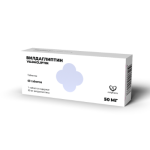Omeprazole
ЛиофилизатStomach glandular secretion lowering agent, proton pump inhibitor

Indications
Omeprazole for intravenous administration is indicated as an alternative to oral therapy in adults for the prevention and treatment of the following diseases and conditions:
- Peptic ulcer of the stomach and duodenum
- Erosive and ulcerative lesions of the stomach and duodenum associated with nonsteroidal anti-inflammatory drugs (NSAIDs)
- Stress ulcers
- Symptomatic gastroesophageal reflux disease (GERD), reflux esophagitis
- Zollinger-Ellison syndrome
- Prevention of aspiration of stomach contents into the respiratory tract during general anesthesia (Mendelssohn syndrome)
Contraindications
- Osteoporosis
- Liver failure
- Concomitant administration of clopidogrel, itraconazole, warfarin, cilostazol, diazepam, phenytoin, saquinavir, tacrolimus, voriconazole, rifampicin, St. John's wort-based drugs, clarithromycin in patients with liver failure
- Vitamin B12 deficiency
- The presence of the following symptoms against the background of a suspected gastric ulcer: significant weight loss, repeated vomiting, vomiting of blood (hematemesis), impaired swallowing, tar–like stools (melena) - ulcer malignancy is possible (omeprazole administration may alleviate symptoms and delay diagnosis)
Use during pregnancy and lactation
The results of 3 prospective epidemiological studies have not revealed any effect of omeprazole on the course of pregnancy or the condition of the fetus/newborn child. Omeprazole can be used during pregnancy in cases where the intended benefit to the mother outweighs the potential risk to the fetus.
Omeprazole is excreted in breast milk, but it is unlikely that it affects the baby when using therapeutic doses. Nevertheless, if possible, the issue of stopping breastfeeding for the period of omeprazole therapy should be resolved.
Usage
The drug is administered intravenously for 20-30 minutes.
If oral therapy is not possible in patients suffering from gastric ulcer, duodenal ulcer and / or reflux esophagitis, omeprazole is administered at a dose of 40 mg once a day.
Zollinger-Ellison syndrome
The dose is selected individually depending on the initial level of gastric secretion, usually starting from 60 mg per day. If necessary, the dose is increased to 80-120 mg per day, dividing it into 2 injections. The duration of treatment in each case is determined by the doctor depending on the patient's condition.
To prevent aspiration of acidic stomach contents into the respiratory tract during general anesthesia (Mendelssohn's syndrome).
The drug is prescribed the night before at a dose of 40 mg and at least 2 hours before anesthesia at a dose of 40 mg.
Patients with impaired liver function
In patients with severe hepatic insufficiency, the daily dose should not exceed 20 mg.
Patients with impaired renal function
In patients with impaired renal function, no dose adjustment is required.
Elderly patients (over 65 years of age)
In elderly patients, no dose adjustment is required.
Instructions for preparation of the infusion solution
The contents of one vial are dissolved in 5 ml, and then immediately diluted to 100 ml with 0.9% sodium chloride solution or 5% glucose solution.
The resulting solution should be homogeneous and transparent from colorless to slightly yellowish in color.
From a microbiological point of view, the diluted drug should be used immediately. The chemical and physical stability of the prepared solution is maintained for 4 hours at a temperature of no more than 25 ° C in a place protected from light.
Preparation:
1. 5 ml of infusion solution is collected into a syringe from a vial or an infusion bag.
2. The infusion solution is injected into a vial of lyophilizate, gently shaken until completely dissolved.
3. Omeprazole solution is injected into the syringe.
4. Transfer the solution to a vial or infusion bag.
5. Repeat operations 1-4 until all omeprazole is transferred to the vial or infusion bag.
Alternative preparation of infusion solution in flexible containers:
1. A double-sided needle (adapter) is used to prepare the solution. One end of the needle is pierced through the membrane of the infusion bag, the other end of the needle is connected to a vial of lyophilizate.
2. The lyophilizate is dissolved by pumping the infusion solution from the bag into the vial and back.
3. After complete dissolution of the lyophilizate, disconnect the empty vial and remove the needle from the infusion bag.
Have questions? Contact Us
Has contraindications. Needs specialist overview.












